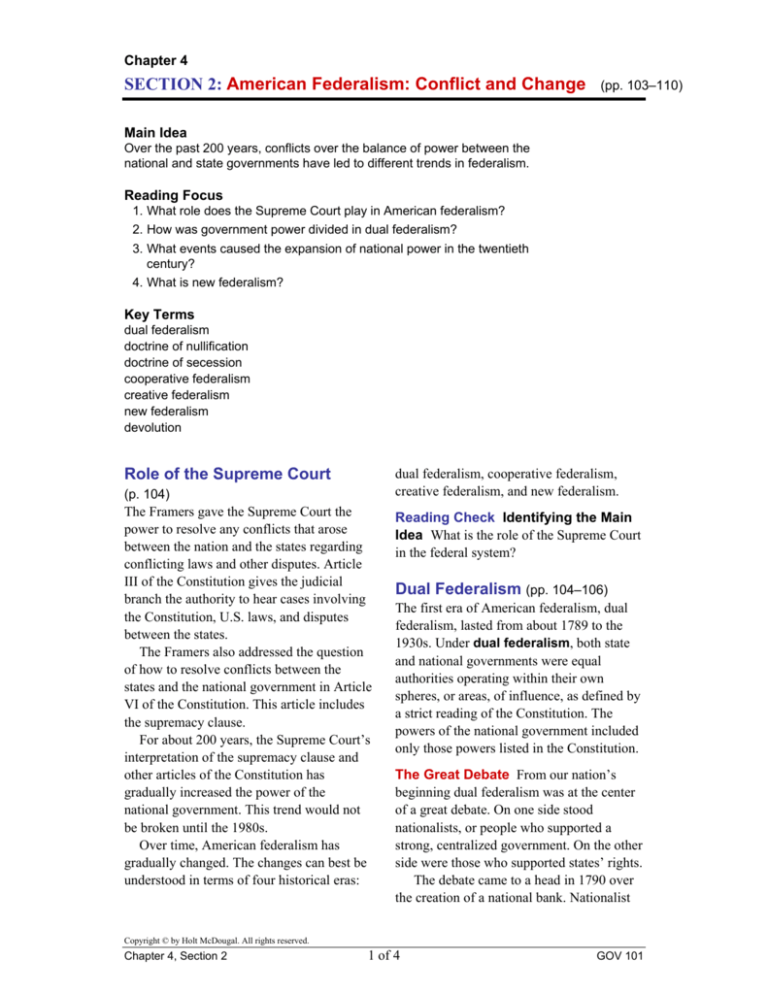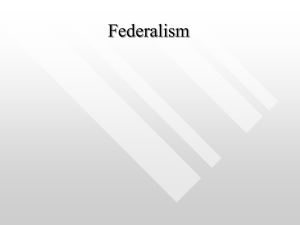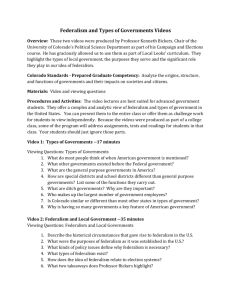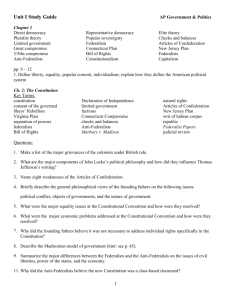
Chapter 4
SECTION 2: American Federalism: Conflict and Change
(pp. 103–110)
Main Idea
Over the past 200 years, conflicts over the balance of power between the
national and state governments have led to different trends in federalism.
Reading Focus
1. What role does the Supreme Court play in American federalism?
2. How was government power divided in dual federalism?
3. What events caused the expansion of national power in the twentieth
century?
4. What is new federalism?
Key Terms
dual federalism
doctrine of nullification
doctrine of secession
cooperative federalism
creative federalism
new federalism
devolution
Role of the Supreme Court
(p. 104)
The Framers gave the Supreme Court the
power to resolve any conflicts that arose
between the nation and the states regarding
conflicting laws and other disputes. Article
III of the Constitution gives the judicial
branch the authority to hear cases involving
the Constitution, U.S. laws, and disputes
between the states.
The Framers also addressed the question
of how to resolve conflicts between the
states and the national government in Article
VI of the Constitution. This article includes
the supremacy clause.
For about 200 years, the Supreme Court’s
interpretation of the supremacy clause and
other articles of the Constitution has
gradually increased the power of the
national government. This trend would not
be broken until the 1980s.
Over time, American federalism has
gradually changed. The changes can best be
understood in terms of four historical eras:
dual federalism, cooperative federalism,
creative federalism, and new federalism.
Reading Check Identifying the Main
Idea What is the role of the Supreme Court
in the federal system?
Dual Federalism (pp. 104–106)
The first era of American federalism, dual
federalism, lasted from about 1789 to the
1930s. Under dual federalism, both state
and national governments were equal
authorities operating within their own
spheres, or areas, of influence, as defined by
a strict reading of the Constitution. The
powers of the national government included
only those powers listed in the Constitution.
The Great Debate From our nation’s
beginning dual federalism was at the center
of a great debate. On one side stood
nationalists, or people who supported a
strong, centralized government. On the other
side were those who supported states’ rights.
The debate came to a head in 1790 over
the creation of a national bank. Nationalist
Copyright © by Holt McDougal. All rights reserved.
Chapter 4, Section 2
1 of 4
GOV 101
Chapter 4, Section 2 continued
Alexander Hamilton urged Congress to
create the bank. States’ rights supporter
Thomas Jefferson opposed its creation,
claiming it was unconstitutional for
Congress to create banks. Hamilton argued
that the power fell under Congress’s ability
to regulate currency. Congress sided with
Hamilton and created a 20-year charter for
the First Bank of the United States.
However, because many questioned the
constitutionality of the action, the charter
was not renewed.
When Congress created the Second Bank
of the United States in 1816, the dispute
began again. Maryland had placed a tax on
all banks operating within the state, but
James McCulloch, an officer at a Maryland
branch of the national bank, refused to pay
the tax.
The Marshall Court The bank dispute
reached the Supreme Court in the case
McCulloch v. Maryland (1819). The Court,
which was strongly nationalist and headed
by Chief Justice John Marshall, ruled in
favor of the nation’s authority to create a
national bank. Marshall said that it was
reasonable for the nation to exercise an
implied power to start a bank since it would
help the nation regulate commerce and
currency. Marshall also said that the states
could not tax a national institution—this
violated the supremacy clause. This case
started a trend of Court rulings that greatly
expanded the powers of the national
government.
“A House Divided” Another issue
wrapped up in arguments over state versus
national power was slavery. The slave
states—the southern states—resisted all
measures taken by the national government
to outlaw slavery in new states and
territories. Politicians in some southern
states believed that states had the right to
nullify, or cancel, national laws that
contradicted or clashed with state interests.
This was known as the doctrine of
nullification.
According to the doctrine of nullification,
if a state challenged a national law, threequarters of the other states would have to
ratify an amendment allowing Congress to
enact the law. At that point, the state that
had challenged the law could either choose
to follow the law or separate from the
Union. The idea that states had the right to
separate themselves from the Union was
known as the doctrine of secession.
Secession, a formal separation, was the most
extreme option for those who believed in
state sovereignty.
The issue of state sovereignty would soon
come to a head. In 1858 the Republican
nominee for an Illinois Senate seat,
Abraham Lincoln, made a speech against the
divisive nature of slavery. He stated that “A
house divided against itself cannot stand.”
He meant that the United States could not
continue half slave, half free. When Lincoln
was elected president in 1860, events
quickly led to secession and the Civil War.
Eleven states seceded and formed the
Confederate States of America. The Civil
War began in 1861 and continued for four
bloody years.
After the Civil War In 1865 the
Confederacy surrendered, and the Union
was restored. Slavery ended, and the
Union’s victory firmly established the
supremacy of the national government.
States could no longer nullify national laws
or withdraw from the Union. Congress’s
powers also expanded with the passage of
the Thirteenth, Fourteenth, and Fifteenth
amendments to the Constitution. These
amendments abolished slavery, defined
citizenship, prohibited states from denying
citizens’ rights, and extended voting rights
to African American men. In time, the
national government would use its new
constitutional powers to protect the rights of
Copyright © by Holt McDougal. All rights reserved.
Chapter 4, Section 2
2 of 4
GOV 101
Chapter 4, Section 2 continued
African Americans, women, and other
groups of people from discrimination by
state and local governments.
Reading Check Identifying
Supporting Details What effect did the
Civil War have on the doctrine of secession?
Expanding National Power (pp.
108–109)
The Civil War reinforced the supremacy of
the national government over the states.
Other challenges in later years continued
this shift in power.
Turn-of-the-Century Reforms The end
of the 1800s was a time of tremendous
change in the United States. New
technologies, such as railroads and the
telegraph, and a growing population
changed how Americans lived and worked.
With these changes came new social and
economic problems. The national
government passed legislation to deal with
many of these problems. Examples of new
legislation include:
• Interstate Commerce Act (1887)—
regulated the railroad industry, setting
restrictions on the rates railroad
companies could charge
• Sherman Antitrust Act (1890)—
prevented monopolies, or the exclusive
control of a good or service in a
particular market
Several Supreme Court cases did limit the
reach of national power, however. In United
States v. E.C. Knight Company (1895), for
example, the Court ruled that a combination
of sugar refining companies was not a
monopoly under the Sherman Antitrust Act.
The New Deal In the 1930s an economic
crisis led to another expansion of the
authority of the federal government. In 1929
the American stock market crashed,
triggering a major economic downturn
known as the Great Depression. Poverty and
unemployment became widespread. In 1933
President Franklin Roosevelt responded with
a relief plan. His program, the New Deal,
created a series of national programs to help
the unemployed, feed the hungry, protect
homeowners, and create jobs. This was the
first time the national government had
assumed responsibility for the social and
economic welfare of its citizens. Since the
national and state governments worked
together to meet the crisis, federalism under
the New Deal was known as cooperative
federalism.
Many New Deal programs were
challenged in court. Opponents argued that
the constitutional powers to tax and regulate
commerce did not give the national
government the power to enact many New
Deal programs. However, the Supreme
Court upheld most New Deal programs.
The Great Society In the 1960s President
Lyndon Johnson further expanded the
powers of the national government with his
Great Society program aimed at ending
poverty and social inequality. Johnson called
his approach to solving national problems
creative federalism. It involved releasing
national funds, in the form of grants to state
and local communities, to achieve national
goals. If the national government thought
that the states were not fully cooperating
with the programs, it could withhold funding
to the states. The grant system greatly
increased the size and cost of national
government. Such spending soon raised
concerns about the power of national
government.
Reading Check Summarizing How
did New Deal and Great Society programs
change federalism?
New Federalism (p. 110)
Throughout much of U.S. history, the
powers of the national government
Copyright © by Holt McDougal. All rights reserved.
Chapter 4, Section 2
3 of 4
GOV 101
Chapter 4, Section 2 continued
expanded. Beginning in the 1980s, many
political leaders worked to reverse this trend
by returning authority to state governments.
This era is known as new federalism.
The Reagan Years During the 1980s
President Ronald Reagan worked to reduce
the size of government by cutting national
grant money to the states. He also relaxed
national requirements on how grant money
could be spent.
The Devolution Revolution Following
Reagan’s example, Republican candidates in
the 1994 congressional elections ran with a
political message they called the Contract
with America. Central to the Contract with
America was the idea of returning power to
states, a concept known as devolution. The
Contract promised to reduce the size and
power of the national government and to
review federal spending.
Some people opposed the Contract,
saying that it would lead to greater social
and economic inequality and end needed
programs. Concerns about the size of
government reached across party lines,
however, leading then Democratic president
Bill Clinton to say: “The era of big
government is over.”
Reading Check Identifying
Supporting Details How did Ronald
Reagan try to reduce the influence of the
national government?
SECTION 2 ASSESSMENT
1. Identify What is the supremacy clause?
2. Recall What is dual federalism?
3. Identify What was the doctrine of nullification?
4. Recall Why were reforms passed at the end of the 1800s?
5. Contrast How did new federalism differ from previous ideas about federalism?
Copyright © by Holt McDougal. All rights reserved.
Chapter 4, Section 2
4 of 4
GOV 101










